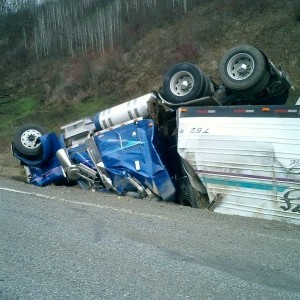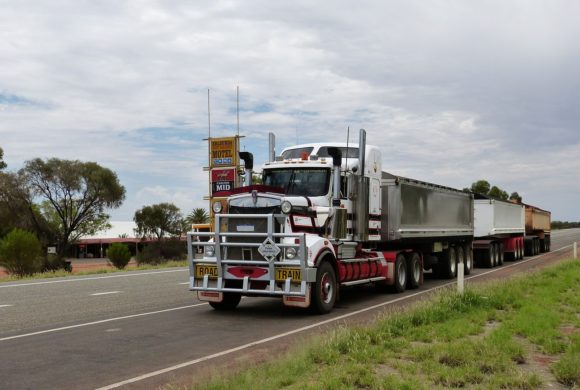
by Queener Law | Dec 29, 2016 | Colorado, Kentucky, Tennessee, Trucking Accident
There are four “no-zones” that surround semi-trucks. A no-zone is an area around a semi-truck wherein most accidents occur. According to the National Highway Traffic Safety Administration (NHTSA), 71 percent of fatal collisions involving two or more vehicles, including a truck, are caused by the other vehicle. Thus, many accidents involving semi-trucks are preventable if passenger vehicles safely share the road.
No-Zones
The no-zone is typified in two situations. First, it is an area around the truck in which the truck driver suffers from reduced visibility (in passenger cars these are called “blind-spots”). Second, it is a zone near the truck in which maneuverability is reduced therefore the truck driver lacks the same timeframe to react as a passenger car.
Blind-spots
Semi-trucks are surrounded by two blind spots, the side, and the rear. Semi-trucks sit significantly higher than passenger vehicles and haul long tractor-trailers. The height and length of the tractor-trailer require larger mirrors that are set further from the driver’s seat. However, the further the mirrors are from the truck, the harder it is for the mirrors to catch objects that are next to the truck. Cars that drive besides semi-trucks are actually in the truck driver’s blind spot; the driver can only see other cars if the driver leans out of the window.
Second, tractor-trailers are taller than the semi-truck. Therefore, they block the rear-view mirror. Truck drivers thus rely on their side mirrors to check behind their trucks. However, side mirrors are inherently incapable of capturing objects that follow too closely. NHTSA recommends that passenger cars follow a minimum of 20 feet behind semi-trucks.
NHTSA recommends drivers follow this golden rule: “if you can’t see the truck driver in his side mirror, he can’t see you.”
Maneuverability
A fully-loaded semi-truck driving 55 mph takes about 400 feet, or 1 and 1/3 a football field, to come to a complete stop. Conversely, the average passenger car takes about 130 feet. NHTSA recommends when merging in front of a semi-truck, passenger cars give trucks several car lengths of distance to ensure adequate time to slow down.
On any turning vehicle, the rear wheels always take a shorter path than the front wheels. To compensate, semi-trucks swing left before turning right. NHTSA recommends that other drivers allow semi-trucks to complete their turn before attempting to pass.

by Queener Law | Dec 20, 2016 | Colorado, Kentucky, Tennessee, Trucking Accident
Liability for a rollover accident involving a large truck is often assigned to the driver, the loader, the maintenance company, the entity operating the truck, or a combination of any of these. Many rollover accidents are not the result of a single cause and so it is necessary to determine what factors played a roll in the vehicle rolling over.
Causes of Large Truck Rollovers
Large trucks can rollover if they take a corner at a high rate of speed. They can roll if they are improperly loaded. They can also roll if they experience a tire blowout. Each of these will considerably shift a vehicle’s center of gravity making it impossible for the driver to maintain control over the vehicle. When a truck rolls over, it is necessary to investigate these and other potential causes to determine which factors led to the accident.
Poor Maintenance is a Common Factor
Faulty brakes, worn tires, and malfunctioning suspension systems make large trucks unsafe to operate. When a truck company, government entity, or independent driver neglects maintenance or chooses to defer necessary repairs, they place other motorists at risk. It is not uncommon for the maintenance record to show that the responsible party neglected proper maintenance prior to a rollover accident.
Assigning Liability for an Accident
Liability for a rollover accident can fall squarely on the driver if they took a corner at excessive speed, or if they chose to operate the vehicle in adverse weather conditions such as high winds. It can be assigned to the manufacturer if a design defect is at fault. It can even be assigned to the cargo loaders if the vehicle was loaded improperly. These are all common reasons for large truck rollovers. Other responsible parties may include a government entity that created hazardous road conditions, or another motorist if their actions led to the truck rolling over.
Because the cause is not always clear, it is often necessary to conduct a thorough accident reconstruction with the assistance of a truck accident attorney. An accident reconstruction can show which factors existed and the extent to which each contributed to the accident. Reconstructions are created using everything from photographs and video evidence, to police statements, insurance records, and maintenance logs. In cases where multiple parties are responsible, each individual or entity can be assigned liability based on their share of responsibility.

by Queener Law | Dec 6, 2016 | Colorado, Kentucky, Tennessee, Trucking Accident
In a recent study of over 240 trucking rollover accidents across the country, the Federal Motor Carrier Safety Administration states that most rollover crashes are due to driver errors that could be prevented. When trucking rollover accidents occur, truck injury lawyers commonly see serious injuries and fatalities to truck drivers, as well as drivers and passengers in automobiles.
Why Do Trucks Roll Over in a Crash?
According to studies by the Federal Motor Carrier Safety Administration, most trucking rollover accidents are caused by truck driver errors. In-depth analysis of accident statistics show:
- Almost one-half of trucking rollover accidents result from failure to adjust speed around curves. When a truck enters a curve, it leans away from the direction of the curve due to centrifugal force. At a high speed, the result is often a rollover where the truck overturns. Due to the high center of gravity and instability, tractor-trailers are particularly vulnerable.
- The second leading cause of truck rollovers is overloaded cargo. Loads are a frequent problem when drivers fail to take account of cargo weight, height and loading procedures, or trucks are loaded before drivers are assigned routes. Rollovers are often caused by top heavy and badly distributed or unsecured loads.
- The third leading cause of truck rollovers is lack of driver attention to the road. Inattentiveness is often due to distractions within the truck, emotional and physical impairments, and drivers dozing or falling asleep behind the wheel. Truck injury lawyerssee many serious trucking accidents caused by driver fatigue.
- The fourth leading cause of truck rollovers involves problems with steering, braking and tires. Many rollover accidents occur when truck drivers don’t control steering properly to stay in a lane, over-steer to avoid lane changes, and over-correct steering to remain on the road. Poorly maintained braking systems and under-inflated tires also cause numerous rollover accidents.
According to accident statistics, the Federal Motor Carrier Safety Administration concluded that truck rollovers are among the deadliest types of trucking accidents. Studies show that the majority of these accidents are caused by truck driver errors which are often completely preventable.
Injuries Caused by Truck Rollover Accidents
When a truck rollover accident occurs, injuries normally affect five main areas of the body – the head and neck, thorax, abdomen, upper limbs and lower limbs. The majority of rollover crash victims sustain multiple injuries throughout these body regions with the head and neck being the most vulnerable area. Some of the most common rollover injuries seen by truck injury lawyers include traumatic head and brain injuries, spinal cord injuries, limb amputations, and broken bones and fractures. These types of injuries are commonly caused from slamming into another vehicle or obstacle, impact with unsecured cargo, contact with broken glass or torn metal, being tossed around within the vehicle, or ejected from the vehicle due to the impact of the crash.
Truck rollover accidents often result in serious injuries and fatalities to everyone involved in the accident. Many accident victims who survive often suffer long-term injuries and chronic pain. The long term effects of rollover injuries can include impairment of critical functions such as speech, vision and memory; emotional and physical disabilities; partial vision loss or blindness; hearing loss; dental injuries and loss of teeth; chronic back pain; amputation or the arms or legs; and a variety of internal damages to nerves, veins, and organs.
Preventing Truck Rollovers
Overcoming the three biggest causes of rollovers, speed, overloading and inattention, present many challenges for the trucking industry. Unfortunately, many truck drivers learn about the causes of rollover accidents by failing to recognize dangerous situations and experiencing rollover crashes first hand. Some crashes might be avoided with roadway changes such as signs that require lower speeds at freeway exits, and vehicle changes like devices that warn truck drivers of dangerous load conditions. However, related costs for these safety measures are significant.
A more affordable solution to reducing truck rollover accidents includes training programs for drivers that discuss rollover prevention measures, especially in large tractor-trailers that are vulnerable to rollovers. Studies show that 69 percent of truck rollover accidents involve tractor-trailers, although the number of registered single-unit trucks on U.S. roadways outnumbers tractor-trailers by nearly three to one.
In recent years, numerous video programs on trucking safety have been developed for the trucking industry with hopes to prevent truck rollover accidents and injuries seen so often by truck injury lawyers. Since statistics show that most truck rollover accidents are the fault of the truck driver, trucking companies often bear significant costs for related injuries. To reduce those liabilities, many trucking companies are focused on improving driver awareness on the causes of rollovers and preventing future accidents. Some companies have developed simulation videos where drivers are presented with rollover situations, then experience the consequences and learn how to safely handle them.

by Queener Law | Nov 23, 2016 | Colorado, Kentucky, Tennessee, Trucking Accident
Semi-truck rollovers cause hundreds of fatalities to truckers and motorists every year. Even though they represent only 3.3% of all semi-truck accidents, rollovers are responsible for nearly 50% of all fatalities suffered by truck drivers nationwide. The following are the most commonly cited reasons seen by semi-truck accident lawyers for semi-trucks toppling over.
Improper Loading & Shifting Loads
A semi-truck’s center of gravity can shift dramatically if it is improperly loaded. If heavier goods are placed on top of lighter goods the vehicle can become highly stable. As a driver navigates down the road, curves in the road, high winds, or sudden stops can cause the vehicle to become uncontrollable.
Another common factor are live loads that can move and shift. A semi-truck loaded with livestock can have a highly mobile cargo. If these animals suddenly move to one side, it can unexpectedly shift the vehicle’s center of gravity and cause it to overturn.
Sharp Turns
Whether it is a gradual turn down the slope of an on-ramp or a sharp corner on a city street, semi-trucks can become unbalanced while conducting these maneuvers. Should the driver lose focus for even an instant as they make a turn, they can lose control over the vehicle as the wheels lift off the road and the vehicle topples.
Bad Roads & Bad Design
Large potholes, soft shoulders, and lax road maintenance can make the roadway unsafe for large vehicles. As the vehicle travels over poorly maintained roads, the driver may not be able to control the vehicle as it encounters these flaws.
Additionally, improperly designed roads can create sharp corners and steep grades. When semi-trucks attempt to navigate poorly designed roads, they may be required to conduct maneuvers that exceed the vehicle’s safe handling limits.
Speeding is another leading cause of semi-truck rollover accidents. A speeding semi-truck has enormous inertia. Semi-truck accident lawyers know that even a gradual turn at a high rate of speed is enough to pull the vehicle over on its side. This problem is even greater if the vehicle is overloaded, in which case the driver will become a victim of the basic principles of physics.
Driver Overcorrection
If a semi-truck driver overcorrects a turn or lane change, the vehicle can become unstable and overturn. Indeed, driver error is a common cause of semi-truck rollover accidents across the nation. It’s a considerable problem with newer, less-experienced drivers that is exacerbated when driver fatigue and other factors are added into the equation.

by Queener Law | Nov 2, 2016 | Colorado, Kentucky, Tennessee, Trucking Accident
Technology is expected to curb the recent rise in fatalities associated with commercial trucks. A series of studies found that the Driver Warning System, the Integrated Safety System, and the Active Chassis Control Systems, among others, will be widely adopted by 2020 and result in significant reduction in fatalities.
Trucks on the Road
Commercial trucks form an integral part of the economy. Commercial trucks, from big rigs to inner-city delivery trucks, shuffle goods all over the country. These trucks deliver Amazon packages, shipments from China, and business deliveries.
Trucks are dangerous because they crowd onto busy boulevards and streets. Trucks make deliveries to important commercial and business center, therefore, trucks must operate on roads utilized by passenger vehicles – it is unavoidable. Furthermore, many of those deliveries are also in high foot-traffic areas, which exposes pedestrians additional danger. Truck drivers are compelled to operate large, slow vehicles in crowded, mixed-use conditions.
Fatalities Caused by Trucks
Despite their relatively small numbers, commercial trucks represent a disproportionate amount of collision fatalities.
According to the National Highway Traffic Safety Administration (NHTSA), fatalities associated with large trucks increased for the fourth consecutive year, totaling 3,964 in 2013. Additionally, market research conducted by Volvo Trucks’ Accident Research Team in Europe found that 90 percent of all truck safety incidents are partly or entirely due to human error.
Trucks are inordinately dangerous for a number of reasons. First, their relative size ensures that most passenger vehicles are obliterated in an accident.
Second, trucks sit much higher than passenger vehicles, so during an accident cars are often pulled down and underneath commercial trucks. The majority of fatalities from commercial truck accidents are caused when passenger cars are crushed by commercial truck tires.
Third, commercial trucks are handled very differently from passenger vehicles, yet fellow drivers do not appreciate the distance they should give commercial trucks.
Fourth, trucks are designed to operate for hundreds of thousands of miles but they require regular maintenance. Truck operators, when crunched by tight deadlines, do occasionally skip or abbreviate required and recommended maintenance.
Active vs. Passive Safety Systems
To address these dangers, truck manufacturers design a variety of systems to improve safety. These systems fall into two types: active and passive.
Active systems are designed to assist drivers in avoiding collisions using alarms and alerts. For example, some trucks are outfitted with lane assist technologies which alert the driver whenever he drifts out of his lane. Passive systems, such as crumple-proof cabins and air bags, are used to reduce the damage from a collision, not avoid it.
Most safety experts believe that as active technologies improve, passive systems will become less and less necessary.
Driving Safety Technologies
Most modern technology is focused on developing active safety systems that alert the driver or include a secondary layer of automated action.
Safety technologies include:
- Driver Information Warning System
- Integrated Safety System
- Active Chassis Control System
- Lane Departure Warning
- Blind Spot Detection Systems
- Braking Assist
All of these technologies already exist in various forms.
For example, driver warning systems have been outfitted on trucks since the 1990s. The most common example are lane-warnings. Modern trucks are often also equipped with brake alerts, rear cameras, and other situational awareness systems.
Brake assists are an area in which autonomous driver technologies are expanding. Brake assists, rather than issue warnings, include a computer which can automatically assert control over the truck and apply the brakes. Very few trucks are outfitted with this system, but wide adoption is expected.
Active chassis control systems are a new area of development. Active Chassis Control Systems take control whenever the computer interprets that the truck is losing control. The Chassis System represents a significant expansion of automation over brake assists.
Projected Adoption Rates
The industry is already beginning to adopt these technologies without legislative impetus. Research conducted by Frost and Sullivan found that the growing awareness of impending legislation has spurred truck fleets to adopt more safety technologies as a way to drive down their total cost of ownership.
In 2013, 409,417 safety systems were outfitted in trucks; by 2020, that number is expected to rise to 917,069 safety systems. Volvo expects that 35 million trucks globally will be connected and outfitted with collision-avoidance systems. Adoption of new safety technologies is critical to ensuring that commercial trucks remain competitive and compliant with new safety regulations.
Burden on Other Drivers
However, despite all of the safety technology, it is ultimately up to the other drivers who share the road with commercial trucks to behave responsibly. The majority of commercial truck accidents are traceable to a mistake committed by the other driver, rather than the truck operator. In the end, no amount of safety technologies can trump the importance of personal responsibility and awareness.

by Queener Law | Oct 20, 2016 | Colorado, Kentucky, Tennessee, Trucking Accident
Thousands of people are injured or killed each year in multi-vehicle accidents involving large trucks. in 2013, 3,964 people were killed, and 95,000 were injured in collisions with large trucks. 274 of these died, and 17,000 were injured in accidents that involved multiple trucks or other vehicles.
Recently, a crash on I-40 outside of Crossville highlighted the dangers of multi-vehicle truck accidents. The accident occurred when a trailerless truck crossed the median and entered the oncoming lane of traffic. The truck hit a Nissan Sentra head on before plowing into another semi-truck, at which point both trucks erupted in flames. The accident killed three people and injured one more.
Truck injury lawyers warn that multiple-Vehicle collisions involving large trucks present a number of hazards to motorists. First, the smaller stature and lighter weight of passenger vehicles makes them prone to compression. These smaller vehicles can become sandwiched between the semi-truck and any vehicles in front of them. In addition to the immediate physical injuries occupants can suffer, occupants can become trapped within the vehicle. This can delay extraction and can be fatal if the injured party is bleeding either internally or externally.
Another considerable risk is the possibility of fire. If the fuel tank on the passenger vehicle or the semi-truck rupture, this can flood the accident scene with flammable gasoline or diesel fuel. Semi-trucks carry up to 300 gallons of diesel that can provide plenty of fuel for a fire to rage out of control. If this fuel ignites, it can create life-threatening burns and lead to the inhalation of toxic fumes from the fire to anyone in the vicinity. Even if the fuel doesn’t ignite, spilled fuel can irritate and damage the respiratory system and lead to toxic shock to anyone who is exposed to wet fuel or vapors.
Multiple-vehicle truck collisions are also known for creating compound injuries. As the vehicle is struck from one angle and pushed into another vehicle at another angle, this can jar drivers and their passengers too and fro in rapid succession. This can lead to whiplash, compound fractures, and blunt force trauma on multiple parts of the body. This can complicate treatment and lead to longer recovery times. The more complex the injuries, and the more complicated the treatment, the greater the impact it will have on the injured party’s life and lifestyle.






